Fur Dynamics
Fur dynamics is the idea of playing with fur lengths, textures, and directions to create a more dynamic look and feel to a fursuit. Instead of using a fursuit with one singular type and length of fur, fur dynamics encourages the use of a variety of lengths and textures. This creates contrast, depth, and interest between the different types of fur.Please note: this is just a guide and my own suggestions! You are welcome to completely disregard everything I say in this guide. It's your fursuit after all :)
Additionally, keep in mind that fur colors can be limited. Sometimes, the exact color of fur you need is only available in one length or texture. I recommend reading my "All About Faux Fur" guide before reading this one as it goes into depth about various types of fur and their qualities.
Table of Contents
Introduction
It's easier for me to explain fur dynamics visually instead of with words. Let's use an example from nature, a fox!
This fox has various types of fur, varying in length, texture, and color. The fur on the fox's arms is much shorter than the fur on its chest. The fur on its tail is long and wiry, versus the straighter fur on its back.
We can apply these ideas onto a fursuit!
Fur Direction
On an animal's face, the fur tends to radiate away from the nose, up the forehead, and down the back of the head/neck. The ears are a bit tricky- the fur goes up towards the tips, even on the back.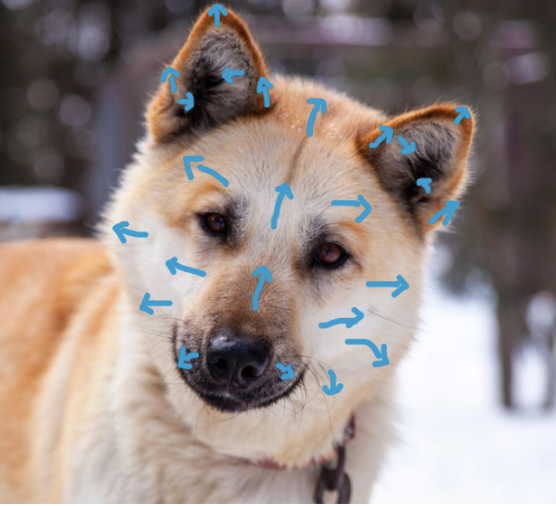
The fur then tends to go down the animal's back and stomach, ending at the tip of the tail. It goes down the arms, towards the paws, and towards the tips of the fingers. Same with the legs. Notice on the coyote how the fur switches direction at the elbows and heels.
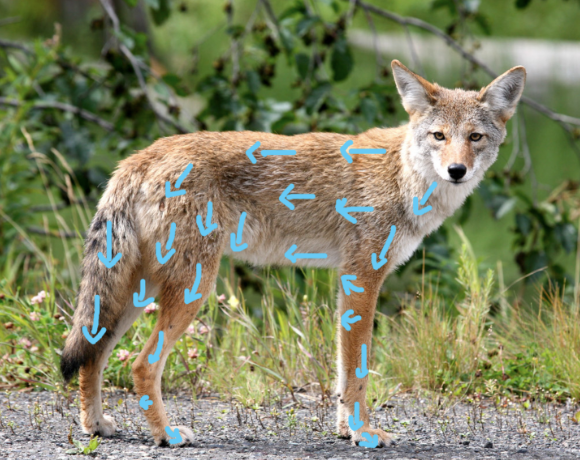
On my fursuits, I follow a similar logic!
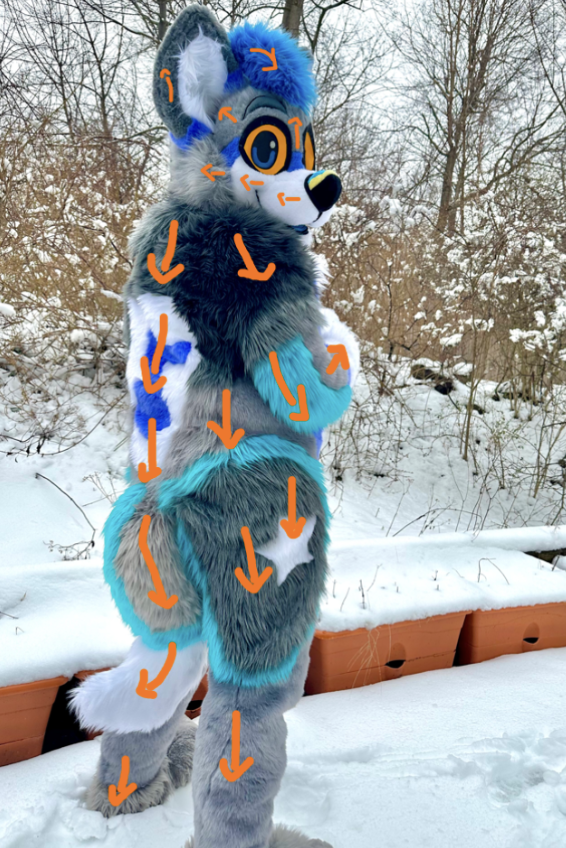
Usually, I simplify the elbows so the fur only goes downwards on the arms. The hair can be in whichever direction you'd like, but I prefer making my hair poofs with the fur going towards the muzzle.
If you are making a fursuit of a critter that isn't usually furred, such as a reptile, but you'd like to use fur anyway, you can still roughly follow the same guides. Alternatively, you can use a short-pile material like minky or short polymink.
Lengths
This is the part where it's very easy and very fun to make lots of stylistic choices!I really enjoy getting to choose which parts of a suit I keep long, and which I shave or use a shorter fur for.
Transitions can be very abrupt for contrast or smoothly fade. Sharp transitions can be done by separating long pieces from short pieces, and smooth transitions can be done with clever shaving. You can also transition furs by using a long fur at its full length, a medium fur at its full length, and then a short fur. I encourage you to experiment!
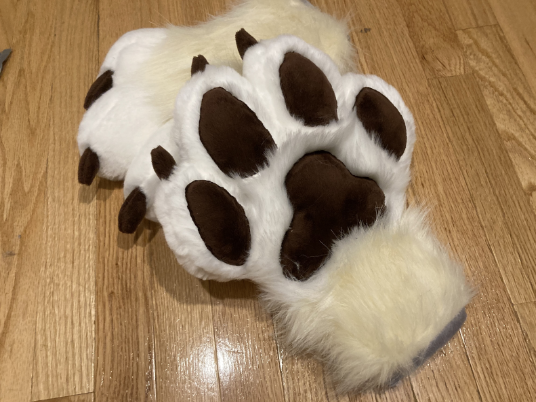
Here's an example of a set of paws I made, featuring deluxe fox fur on the wrists, luxury teddy on the palms, and beaver on the fingers. This features the aforementioned full-length transition.
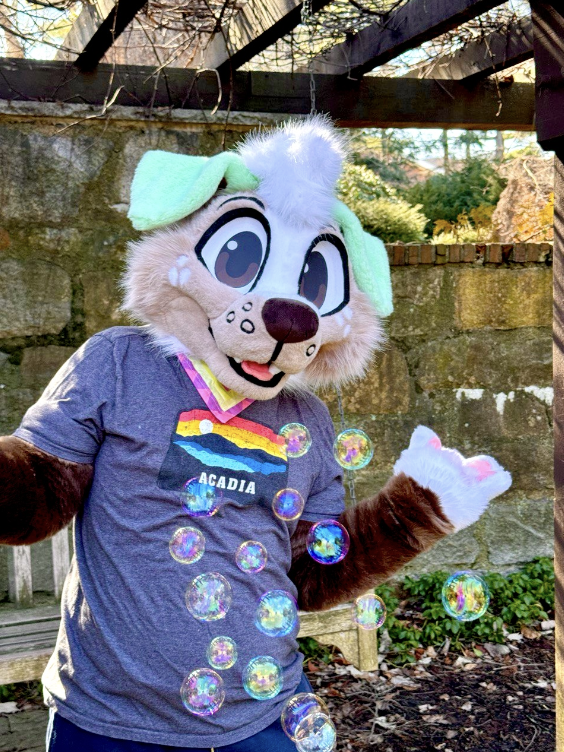
Hunterkinz' cheeks feature a smooth transition. During patterning, I made sure the cheek fluff was a separate piece from his actual cheeks. I made the cheek fluff piece completely long, and the actual cheek a "fade" piece. Most of the actual cheek piece was shaved, apart from the very edge that connected to the cheek fluff.
Generally, I like to use denser fur for the face, such as teddy, beaver, or deluxe fox. I'll use luxury shag if I can't find a decent color match.
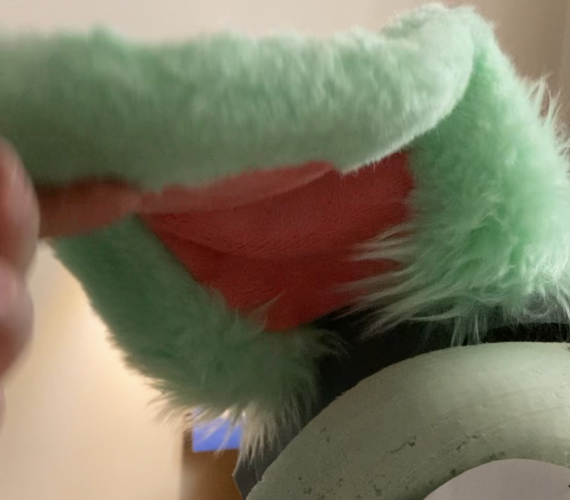
His ears utilized a similar method. I shaved most of the ear pieces but kept the base short.

Despite only utilizing two fur lengths for the orange, Mango's suit still utilizes fur length contrast. His arms are made of luxury teddy with some luxury shag at the elbows. He has a luxury shag on his chest that immediately flows into a luxury teddy on his stomach. The torso is a great place to introduce length contrast! Although I used shag because of limited colors, you can use a longer fur such as deluxe fox or monster to pair with teddy. You could run a trail of longer fur down the center of the chest, or make the neck/chest area more voluminous.
Don't be afraid to vary fur lengths in other areas as well! Long undersides of tails vs short upper surfaces, ear tufts, facial hair, manes, heel tufts, outer thigh vs inner thigh, the forehead area between the eyes and ears, etc.
Textures
If you've already taken care of varying lengths, you likely have textures covered as well. Luxury shag, deluxe fox, beaver, and luxury teddy all have different textures.However, certain textured fur can help accentuate certain species.
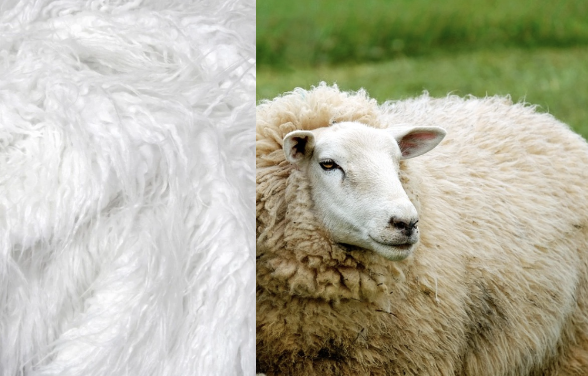
Mongolian fur can be hard to incorporate for many suits but works perfectly for the longer fur on a sheep.
You may want to use a coarser fur on a mane or a softer fur for the belly.
Putting it all Together
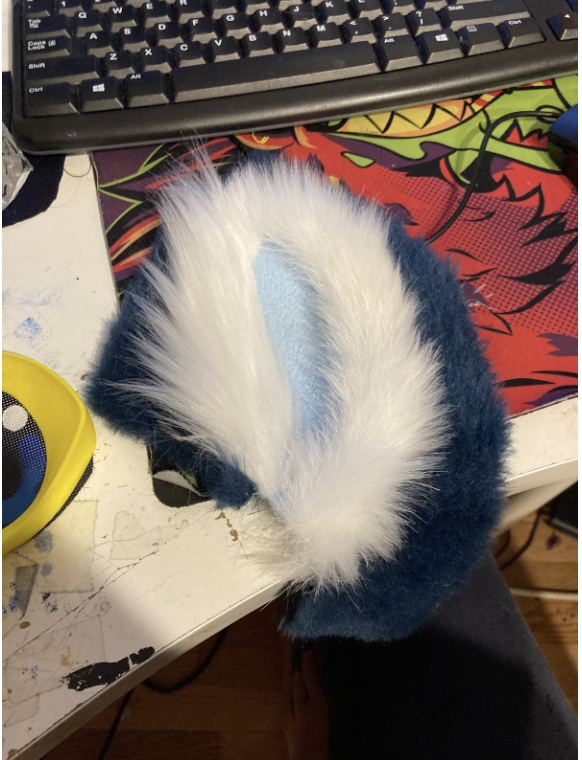
This is an ear I made back in 2021. I still really like this ear because of the great fur dynamics!
The navy blue is made from shaved-down luxury shag, the shorter white fur is luxury teddy, and the longer white is luxury shag. The baby blue material is minky that was thickened with iron-on fusible fleece on the back.
There is a lot of length contrast between the blues and the whites. The white luxury teddy has a very different texture compared to the white luxury shag.
I stylized the directions of the longer fur to make it go outwards rather than inwards in the reference photos, but this worked to my advantage as I let the minky shine through since this was a flat ear with little surface area.
If I were to remake this ear today, the only thing I would change would be keeping the navy blue base longer.
Fur dynamics is easiest if you have a decent-sized fur stash with a variety of different types of furs. If you are making a fursuit for the first time, it may be more economical to get scraps from other makers for your small accents. You can also buy half-yard amounts, and repurpose the leftovers into new suits, plushies, or to sell to another maker who may need it for their own suit. Enjoy playing with fur dynamics!
Attributes
Thank you Xavier/Prectriv for editing!Fox photo:
https://commons.wikimedia.org/wiki/File:Vulpes_vulpes_ssp_fulvus.jpg
Dog portrait photo:
https://pixnio.com/fauna-animals/dogs/dog-husky-canine-pet-cute-animal-portrait-puppy-fur
Coyote photo:
https://www.flickr.com/photos/jitze1942/1751241022/
Sheep photo:
https://pixabay.com/photos/sheep-lamb-affection-cute-pasture-1320940/
Back to top
